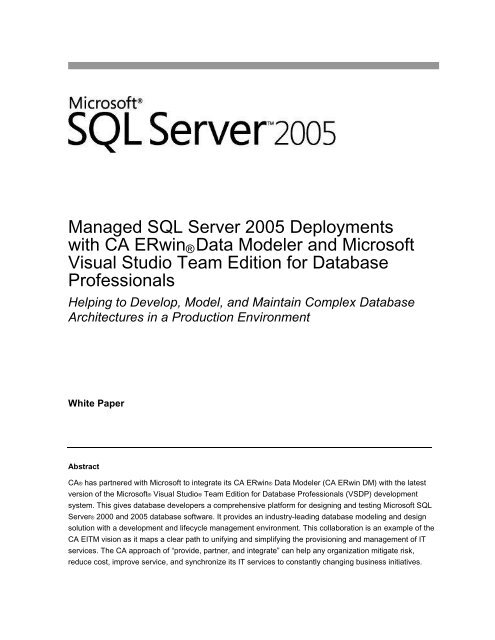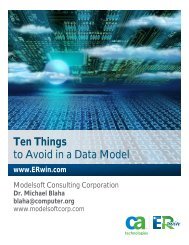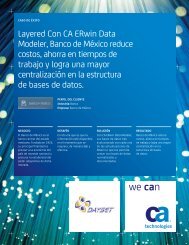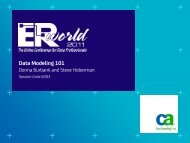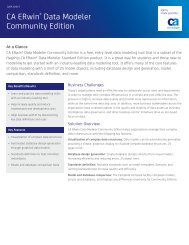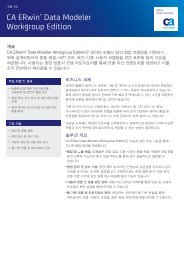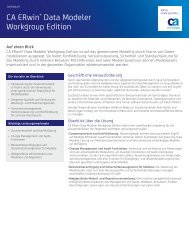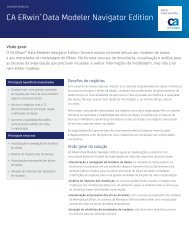CA ERwin Data Modeler for Microsoft Visual Studio and SQL Server
CA ERwin Data Modeler for Microsoft Visual Studio and SQL Server
CA ERwin Data Modeler for Microsoft Visual Studio and SQL Server
You also want an ePaper? Increase the reach of your titles
YUMPU automatically turns print PDFs into web optimized ePapers that Google loves.
Managed <strong>SQL</strong> <strong>Server</strong> 2005 Deploymentswith <strong>CA</strong> <strong>ERwin</strong> ® <strong>Data</strong> <strong>Modeler</strong> <strong>and</strong> <strong>Microsoft</strong><strong>Visual</strong> <strong>Studio</strong> Team Edition <strong>for</strong> <strong>Data</strong>baseProfessionalsHelping to Develop, Model, <strong>and</strong> Maintain Complex <strong>Data</strong>baseArchitectures in a Production EnvironmentWhite PaperAbstract<strong>CA</strong>® has partnered with <strong>Microsoft</strong> to integrate its <strong>CA</strong> <strong>ERwin</strong>® <strong>Data</strong> <strong>Modeler</strong> (<strong>CA</strong> <strong>ERwin</strong> DM) with the latestversion of the <strong>Microsoft</strong>® <strong>Visual</strong> <strong>Studio</strong>® Team Edition <strong>for</strong> <strong>Data</strong>base Professionals (VSDP) developmentsystem. This gives database developers a comprehensive plat<strong>for</strong>m <strong>for</strong> designing <strong>and</strong> testing <strong>Microsoft</strong> <strong>SQL</strong><strong>Server</strong>® 2000 <strong>and</strong> 2005 database software. It provides an industry-leading database modeling <strong>and</strong> designsolution with a development <strong>and</strong> lifecycle management environment. This collaboration is an example of the<strong>CA</strong> EITM vision as it maps a clear path to unifying <strong>and</strong> simplifying the provisioning <strong>and</strong> management of ITservices. The <strong>CA</strong> approach of ―provide, partner, <strong>and</strong> integrate‖ can help any organization mitigate risk,reduce cost, improve service, <strong>and</strong> synchronize its IT services to constantly changing business initiatives.
ContentsIntroduction ............................................................................................................................................... 1The Challenge of IT Administration .......................................................................................................... 1EITM: The <strong>CA</strong> Comprehensive IT Management Solution .................................................................... 1How <strong>Data</strong>base Management Can Benefit from EITM ....................................................................... 2The <strong>CA</strong> <strong>ERwin</strong> DM Role in EITM <strong>and</strong> <strong>Data</strong>base Management ......................................................... 2Advantages of Using <strong>Microsoft</strong> <strong>Visual</strong> <strong>Studio</strong> Team Edition <strong>for</strong> <strong>Data</strong>base Professionals <strong>for</strong> <strong>Data</strong>baseManagement......................................................................................................................................... 4Examples of How <strong>CA</strong> <strong>ERwin</strong> DM <strong>and</strong> VSDP Make <strong>Data</strong>base Management Tasks Easier ..................... 5Scenario 1: Applying Existing St<strong>and</strong>ards to a New <strong>Data</strong>base Application Set .................................... 5Scenario 2: Migrating Existing <strong>Data</strong>base Applications to <strong>SQL</strong> <strong>Server</strong> 2005 ........................................ 6Scenario 3: Integrating Newly Developed <strong>Data</strong>base Systems <strong>and</strong> an Existing Analytical Plat<strong>for</strong>m .... 7Scenario 4: Design <strong>Visual</strong>ization <strong>and</strong> <strong>Data</strong> Modeling in the VSDP <strong>and</strong> <strong>SQL</strong> <strong>Server</strong> Environments ... 7Conclusion ................................................................................................................................................ 8About <strong>CA</strong> .................................................................................................................................................. 9
IntroductionAs <strong>Microsoft</strong>® <strong>SQL</strong> <strong>Server</strong>® 2005 database software emerges as an important enterprise-classdatabase plat<strong>for</strong>m, organizations that use <strong>SQL</strong> <strong>Server</strong> also need enterprise-class support to assurereliable per<strong>for</strong>mance. The successes of IBM’s DB2 relational database product in the mainframebaseddatabase market <strong>and</strong> Oracle in the distributed database market prove to many CIOs that acompany’s strategic IT infrastructure relies as much on its supporting processes <strong>and</strong> tools as it doesthe horsepower <strong>and</strong> functionality of the database management system. IT Infrastructure Library (ITIL)best-practice guidelines state that the value of rigorous service management extends to itsdevelopment <strong>and</strong> operational processes, <strong>and</strong> an organization’s strategic database architecture is agood example of this.Fortunately, <strong>CA</strong> <strong>and</strong> <strong>Microsoft</strong> offer a solution that benefits from the cost effectiveness <strong>and</strong> competitivefunctionality of <strong>SQL</strong> <strong>Server</strong> <strong>and</strong> offers a robust development <strong>and</strong> testing plat<strong>for</strong>m <strong>for</strong> databaseapplications.The purpose of this white paper is to address the need <strong>for</strong> organizations to adopt best-practiceguidelines in building an enterprise-class service architecture, <strong>and</strong> to briefly describe the tools that <strong>CA</strong><strong>and</strong> <strong>Microsoft</strong> provide to implement those guidelines.The Challenge of IT AdministrationMany companies are increasingly dependent on complex IT infrastructure to manage their suppliers<strong>and</strong> partners, organize their internal processes, coordinate with distribution channels, <strong>and</strong> interact withcustomers. Especially in today’s competitive business environment, business managers need their ITinfrastructure to work well <strong>and</strong> reliably, <strong>and</strong> to accommodate quickly changing business strategies.This places enormous pressure on IT organizations because the applications <strong>and</strong> services thatcomprise the IT infrastructure are often also extremely complex <strong>and</strong> difficult to develop <strong>and</strong> manage. Itis hard <strong>for</strong> business managers to make effective business decisions when they cannot underst<strong>and</strong> thetechnology that enables their business to operate.Because of this difficulty, IT organizations must find ways to streamline their ef<strong>for</strong>ts <strong>and</strong> work as acohesive unit with their business counterparts to deliver high-quality services. The multi-tiered <strong>and</strong>networked applications that deliver business services require a multidisciplinary approach to meet theneeds of the business operations. The ITIL framework is a set of best-practice guidelines that promotethis goal by linking business perspectives with IT infrastructure management.A successful implementation of the ITIL service management guidelines cannot be achieved withoutcareful planning in the design of the organization’s service architecture. Each business has its own ITrequirements, <strong>and</strong> if IT technology is misapplied, it can increase costs <strong>and</strong> inefficiency rather thanreduce them. The unavoidable complexity of IT infrastructure technologies makes it necessary to usepowerful tools <strong>and</strong> approaches to ensure that the goal of ITIL best-practice guidelines is realized.EITM: The <strong>CA</strong> Comprehensive IT Management SolutionThe <strong>CA</strong> approach to enable ITIL <strong>and</strong> other best-practice guidelines is Enterprise IT Management, orEITM. Its aim is to provide IT staff an integrated framework <strong>for</strong> managing the entire IT infrastructureaccording to the principles of ―provide, partner, <strong>and</strong> integrate.‖EITM provides IT organizations <strong>and</strong> business-management teams with a comprehensive <strong>and</strong> cohesiveview of the IT operations to help them manage risk <strong>and</strong> costs, improve service, <strong>and</strong> align their ITinvestments to support new <strong>and</strong> existing business processes. This fulfills the ITIL requirement of IT<strong>CA</strong> <strong>ERwin</strong> DM <strong>for</strong> <strong>Microsoft</strong> <strong>Visual</strong> <strong>Studio</strong> <strong>and</strong> <strong>SQL</strong> <strong>Server</strong> 1
Governance, which m<strong>and</strong>ates that decisions about IT operations must be governed by all businessmanagement, <strong>and</strong> not just IT management.Because ITIL guidelines do not advocate a specific vendor’s solution, EITM partners with <strong>and</strong>complements the management <strong>and</strong> security solutions not provided by <strong>CA</strong>. And EITM integratesexisting management tools <strong>and</strong> business processes so that the IT infrastructure can support businesstransactions in a consistent <strong>and</strong> automated way.How <strong>Data</strong>base Management Can Benefit from EITMAn area of IT management where the idea of ―provide, partner, <strong>and</strong> integrate‖ is particularly useful isthe development <strong>and</strong> management of an organization’s database architecture. The databasearchitecture is one of the foundations of an effective IT infrastructure. As such, it is crucial that thearchitecture be rigorously designed, efficiently implemented, <strong>and</strong> flexible enough to accommodateexpansion <strong>and</strong> modification as changing business needs dictate. IT management <strong>and</strong> businessmanagement must know how their database resources are configured <strong>and</strong> how well those resourcesare meeting their business requirements at all times, <strong>and</strong> the EITM framework, along with the tools <strong>and</strong>technologies that support it, provides this knowledge.Because a company’s database architecture develops over many years, it typically relies on severaldatabase management applications across its IT infrastructure. For example, a data transaction maytake place between an Oracle relational database <strong>and</strong> several discrete databases managed by<strong>Microsoft</strong> <strong>SQL</strong> <strong>Server</strong> 2005. Integral to the EITM solution is the ability to track <strong>and</strong> manage thedatabase management solutions of different vendors in an integrated way. EITM can provide businessmanagement with an accurate <strong>and</strong> comprehensive bird’s-eye view of the quality of service provided bythe database architecture. Business management can then determine whether the architecture needsto be modified if the quality of service is not acceptable.This ability to monitor <strong>and</strong> assess database operations is also useful in the lifecycle support of thedatabase architecture. When the entire database structure needs to be changed, it is time-consuming<strong>and</strong> inefficient to per<strong>for</strong>m these changes piecemeal, using the tools <strong>and</strong> processes provided by eachvendor. EITM makes upgrading heterogeneous database implementations more efficient by partneringwith <strong>and</strong> complementing each vendor’s tools <strong>and</strong> technologies, thereby providing the databasemodeling <strong>and</strong> processing capabilities that allow IT managers to design <strong>and</strong> test the entire databasestructure as one unit.The <strong>CA</strong> <strong>ERwin</strong> DM Role in EITM <strong>and</strong> <strong>Data</strong>base Management<strong>CA</strong> <strong>ERwin</strong> DM is a powerful software application that analyzes <strong>and</strong> models in<strong>for</strong>mation systems suchas data warehouses, enterprise data resource models, <strong>and</strong> databases. It can display the structure of adistributed database system in an easy-to-underst<strong>and</strong>, graphical <strong>for</strong>mat, enabling business <strong>and</strong> ITmanagers to easily visualize the state of their data resources <strong>and</strong> plan optimizations. With <strong>CA</strong> <strong>ERwin</strong>DM, design issues can be quickly identified <strong>and</strong> addressed early in the design process. <strong>CA</strong> <strong>ERwin</strong> DMis an integral part of the <strong>CA</strong> EITM vision <strong>and</strong> a valuable resource <strong>for</strong> businesses adopting ITIL bestpracticeguidelines.<strong>CA</strong> <strong>ERwin</strong> DM <strong>for</strong> <strong>Microsoft</strong> <strong>Visual</strong> <strong>Studio</strong> <strong>and</strong> <strong>SQL</strong> <strong>Server</strong> 2
Figure 1. The <strong>CA</strong> ERWin DM <strong>Data</strong> <strong>Visual</strong>ization InterfaceSpecifically, <strong>CA</strong> <strong>ERwin</strong> DM capabilities include:Logical <strong>and</strong> Physical Model-Driven <strong>Data</strong>base Development. <strong>CA</strong> <strong>ERwin</strong> DM can createlogical models of database structures, which are representations of the structure that can begeneralized <strong>for</strong> all implementations of the database. Logical names <strong>and</strong> descriptions of entities<strong>and</strong> descriptions, logical domains, <strong>and</strong> logical data types are supported.<strong>CA</strong> <strong>ERwin</strong> DM can also create physical models of database structures from the logical models.Physical models are instances of the logical model with the specific attributes particular to aninstance. Combinations of logical <strong>and</strong> physical models are also supported.There are several advantages to model-driven development: First, it enables databasearchitects to analyze <strong>and</strong> optimize the design of a database schema be<strong>for</strong>e implementing it,saving time <strong>and</strong> money in the design process. The business rules can be verified, internal <strong>and</strong>external consistency can be checked, <strong>and</strong> the maintainability of the design can be ensuredwhile still in the pre-prototype stage. Second, a model can be used to generate a database thatcan then be modified into a unique implementation, saving time <strong>and</strong> money by making itunnecessary to create every database from scratch. And last, because the model is a compact<strong>and</strong> accurate representation of the database schema, it can be easily archived <strong>for</strong> later reuse,incremental update, or publication in context.<strong>CA</strong> <strong>ERwin</strong> DM <strong>for</strong> <strong>Microsoft</strong> <strong>Visual</strong> <strong>Studio</strong> <strong>and</strong> <strong>SQL</strong> <strong>Server</strong> 3
Forward <strong>and</strong> Reverse Engineering. In <strong>for</strong>ward engineering, <strong>CA</strong> <strong>ERwin</strong> DM analyzes thephysical model <strong>and</strong> generates <strong>SQL</strong> or DDL script that can be run to create the correspondingdatabase schema. In reverse engineering, <strong>CA</strong> <strong>ERwin</strong> DM analyzes a database schema <strong>and</strong>generates the corresponding physical model. Forward <strong>and</strong> reverse engineering can beper<strong>for</strong>med in one operation—this is referred to as ―Complete Compare‖—to facilitate seamlessround-trip schema engineering.Model-to-Model Comparison. <strong>CA</strong> <strong>ERwin</strong> DM can also compare two model files with―Complete Compare‖ in order to track model changes as well as share model objects.Integrated <strong>Data</strong>base Analysis <strong>and</strong> Modeling. <strong>CA</strong> <strong>ERwin</strong> DM can analyze multivendordatabase architectures <strong>and</strong> use the results of the analysis to model new architectures.Collaborative Design Task Automation. The <strong>CA</strong> <strong>ERwin</strong> Model Manager enables teams ofdesigners to collectively create, share, <strong>and</strong> manage their modeling <strong>and</strong> design processesthrough rigorous model management.Integration with <strong>SQL</strong> <strong>Server</strong>. <strong>SQL</strong> <strong>Server</strong> is becoming a database management solution <strong>for</strong>enterprise-wide database implementations, <strong>and</strong> <strong>CA</strong> <strong>ERwin</strong> DM provides extensive support <strong>for</strong><strong>SQL</strong> <strong>Server</strong> 2000 <strong>and</strong> 2005.Advantages of Using <strong>Microsoft</strong> <strong>Visual</strong> <strong>Studio</strong> Team Edition <strong>for</strong> <strong>Data</strong>baseProfessionals <strong>for</strong> <strong>Data</strong>base Management<strong>Microsoft</strong> <strong>Visual</strong> <strong>Studio</strong>® Team Edition <strong>for</strong> <strong>Data</strong>base Professionals (VSDP) was introduced in 2006 toprovide database designers with the tools <strong>for</strong> collaborative development, schema maintenance, <strong>and</strong>database deployment. It features extensive support <strong>for</strong> <strong>SQL</strong> <strong>Server</strong> 2005 <strong>and</strong> earlier versions, takingadvantage of the growing prominence of <strong>SQL</strong> <strong>Server</strong> as a high-per<strong>for</strong>mance, enterprise-level databaseplat<strong>for</strong>m. VSDP is designed to be a comprehensive development <strong>and</strong> schema managementenvironment with the following capabilities:Integrated Source Control. VSDP supports all source code control environments offered by<strong>Visual</strong> <strong>Studio</strong> 2005, <strong>and</strong> the combination of VSDP <strong>and</strong> Team Foundation <strong>Server</strong> (TFS) offersintegrated source control within application lifecycle management features such as work items<strong>and</strong> bug tracking. Each member of the development team can create a baseline version of thefiles, compare <strong>and</strong> shelve versions, branch <strong>and</strong> merge versions, <strong>and</strong> check in <strong>and</strong> check outversions concurrently with other team members in a collaborative environment.Comprehensive Test Environment. Using VSDP, developers can create full unit tests <strong>for</strong>database applications <strong>and</strong> schemas driven by T-<strong>SQL</strong> scripts or managed <strong>Microsoft</strong> <strong>Visual</strong> C#®<strong>and</strong> <strong>Visual</strong> Basic® development systems code. These tests can be run privately on thedeveloper’s workstation or as part of the daily or continuous team build, <strong>and</strong> they provide amechanism <strong>for</strong> centrally measuring <strong>and</strong> reporting quality metrics <strong>for</strong> the application <strong>and</strong>database tiers. VSDP can also write test data to the physical database to verify the integrity ofthe deployment.When a development database has been tested, you can use VSDP to deploy the testeddatabase to a staging server. During deployment, VSDP automatically creates a change scriptby comparing the schema of the development database with the schema of the developmentdatabase. Developers can then run these change scripts to synchronize the two schemas. Thissaves the organization time <strong>and</strong> money by making it unnecessary <strong>for</strong> developers to createthese change scripts from scratch, <strong>and</strong> it eliminates the possibility <strong>for</strong> mistakes that can occurwhen change scripts are maintained manually.<strong>CA</strong> <strong>ERwin</strong> DM <strong>for</strong> <strong>Microsoft</strong> <strong>Visual</strong> <strong>Studio</strong> <strong>and</strong> <strong>SQL</strong> <strong>Server</strong> 4
Effective Team Collaboration. With VSDP <strong>and</strong> TFS, members of the development <strong>and</strong>management teams can communicate <strong>and</strong> collaborate through the customizable, Webservice–based Application Lifecycle Management (ALM) service. VSDP works with the ALMusing TFS database–oriented workstreams <strong>and</strong> work items, bug-tracking capability, <strong>and</strong> theproject management <strong>and</strong> reporting functionality. All aspects of the application <strong>and</strong> databasetiers are fully visible to developers <strong>and</strong> management. Project specification documents can alsobe published on a Web-hosted team portal page.Developers can use the <strong>SQL</strong> <strong>Server</strong> 2005 Reporting Service with TFS to generate detailedreports on any aspect of the development process—<strong>for</strong> example, the rate of code change overtime, lists of unresolved bugs, <strong>and</strong> the results of regression tests. These reports can beexported to several file <strong>for</strong>mats, including <strong>Microsoft</strong> Office Excel® spreadsheet software <strong>for</strong>mat,XML, PDF, <strong>and</strong> TIFF. Reports can be accessed by managers <strong>and</strong> team members using <strong>Visual</strong><strong>Studio</strong> <strong>and</strong> can also be published on the team portal page.<strong>CA</strong> <strong>and</strong> <strong>Microsoft</strong> recognized that VSDP <strong>and</strong> the <strong>CA</strong> <strong>ERwin</strong> DM <strong>Data</strong> Modeling Suite hadcomplementary capabilities. VSDP has the schema change management <strong>and</strong> lifecycle managementfunctionality that more fully leverages the value of modeling with <strong>CA</strong> <strong>ERwin</strong> DM. <strong>CA</strong> <strong>ERwin</strong> DM offersthe design visualization <strong>and</strong> st<strong>and</strong>ardization capabilities to enhance design <strong>and</strong> st<strong>and</strong>ardizationcapabilities of the IDE provided by VSDP . Because of this, <strong>and</strong> because both products have extensivesupport <strong>for</strong> <strong>SQL</strong> <strong>Server</strong> 2000 <strong>and</strong> 2005, <strong>CA</strong> <strong>and</strong> <strong>Microsoft</strong> made <strong>CA</strong> <strong>ERwin</strong> DM an integral extension ofVSDP.Examples of How <strong>CA</strong> <strong>ERwin</strong> DM <strong>and</strong> VSDP Make <strong>Data</strong>baseManagement Tasks EasierThe following three examples illustrate how <strong>CA</strong> <strong>ERwin</strong> DM <strong>and</strong> VSDP can be used in an integratedway to solve common database management tasks.Scenario 1: Applying Existing St<strong>and</strong>ards to a New <strong>Data</strong>base Application SetAn organization is incorporating VSDP <strong>and</strong> <strong>SQL</strong> <strong>Server</strong> 2005 into its database architecture <strong>and</strong> wantsto take advantage of a mature <strong>and</strong> well-tested set of database <strong>and</strong> data administration st<strong>and</strong>ards. ITpersonnel must apply these st<strong>and</strong>ards—which include naming, st<strong>and</strong>ard data types, user-defined datatypes, <strong>and</strong> data definitions—to all new database applications within the organization. They must alsoapply appropriate de-normalizations to these st<strong>and</strong>ards.Approach1. The st<strong>and</strong>ards are defined <strong>and</strong> captured <strong>for</strong> reuse by <strong>CA</strong> <strong>ERwin</strong> DM.2. <strong>CA</strong> <strong>ERwin</strong> DM is used to identify <strong>and</strong> establish the appropriate st<strong>and</strong>ards, trans<strong>for</strong>m them tobe <strong>SQL</strong> <strong>Server</strong> 2005–compatible, incorporate them in the new design <strong>and</strong> generate theupdated VSDP managed objects.3. VSDP is used to manage the development/testing/deployment of new/changed schema acrossthe enterprise.BenefitsFrom the outset, the new database architecture is in compliance with the established st<strong>and</strong>ards <strong>and</strong> isthere<strong>for</strong>e consistent with the other data assets of the organization. Because the work is based onproven best-practice guidelines, the old st<strong>and</strong>ards are integrated into the new applications only once.The user of the new database architecture is not burdened with the task of adapting to new st<strong>and</strong>ards,<strong>and</strong> IT staff is not burdened with the difficulties of developing <strong>and</strong> maintaining architectures based onnew st<strong>and</strong>ards.<strong>CA</strong> <strong>ERwin</strong> DM <strong>for</strong> <strong>Microsoft</strong> <strong>Visual</strong> <strong>Studio</strong> <strong>and</strong> <strong>SQL</strong> <strong>Server</strong> 5
Scenario 2: Migrating Existing <strong>Data</strong>base Applications to <strong>SQL</strong> <strong>Server</strong> 2005An organization is migrating database applications developed on its legacy plat<strong>for</strong>ms (Oracle, DB2,<strong>and</strong> Sybase) to <strong>SQL</strong> <strong>Server</strong> 2005.Approach1. The database applications are modeled in <strong>CA</strong> <strong>ERwin</strong> DM. (Another option is to reverseengineerthem into a <strong>CA</strong> <strong>ERwin</strong> DM model.)2. <strong>SQL</strong> <strong>Server</strong> 2005 is designated a new target DBMS in <strong>CA</strong> <strong>ERwin</strong> DM, <strong>and</strong> the majority of theschema objects are made compatible with <strong>SQL</strong> <strong>Server</strong> 2005.3. The schema objects are analyzed <strong>for</strong> proper alignment with business requirements be<strong>for</strong>eredeployment to <strong>SQL</strong> <strong>Server</strong> 2005. They can also be converted to VSDP-managed objects <strong>for</strong>managed development <strong>and</strong> deployment. Figure 2 shows VSDP communicating with <strong>CA</strong> <strong>ERwin</strong>DM.Figure 2. VSDP Reverse-engineering a <strong>Data</strong>base ApplicationBenefitsThe automation <strong>and</strong> visualization capabilities of <strong>CA</strong> <strong>ERwin</strong> DM significantly reduce the costs ofmigration <strong>and</strong> redevelopment. They provide developers a foundation to build on, enabling them to<strong>CA</strong> <strong>ERwin</strong> DM <strong>for</strong> <strong>Microsoft</strong> <strong>Visual</strong> <strong>Studio</strong> <strong>and</strong> <strong>SQL</strong> <strong>Server</strong> 6
quickly identify changes between the versions <strong>and</strong> to efficiently analyze, optimize, <strong>and</strong> augment thedesign as necessary to comply with the new business requirements be<strong>for</strong>e redeployment.Scenario 3: Integrating Newly Developed <strong>Data</strong>base Systems <strong>and</strong> anExisting Analytical Plat<strong>for</strong>mAn organization operates a data warehouse as an analytical infrastructure where all operational data<strong>for</strong> business intelligence purposes is kept. The legacy source systems of this data warehouse <strong>and</strong> allderived data warehouses have been modeled by <strong>CA</strong> <strong>ERwin</strong> DM. New systems deployed on <strong>SQL</strong><strong>Server</strong> 2005 <strong>and</strong> managed by VSDP must be quickly integrated into this analytical infrastructure tohelp the organization’s strategic decision makers.Approach1. Reverse-engineer the <strong>SQL</strong> <strong>Server</strong> 2005–based applications either natively or as VSDPmanagedobjects using <strong>CA</strong> <strong>ERwin</strong> DM.2. Forward-engineer the applications into the warehouse environment.3. The meta data exchange tool in <strong>CA</strong> <strong>ERwin</strong> DM trans<strong>for</strong>ms <strong>and</strong> exchanges model metadata. toprovide critical source system metadata to the ETL (Extract, Trans<strong>for</strong>m, <strong>and</strong> Load) tool.4. Use the meta data exchange tool to provide warehouse data definitions as metadata to thebusiness intelligence <strong>and</strong> reporting tools.5. Use the RTB (Report Template Builder) tool in <strong>CA</strong> <strong>ERwin</strong> DM to publish Web-based reports<strong>and</strong> definitions to the end-user community so that users can underst<strong>and</strong>, trust, <strong>and</strong> take betteradvantage of the new data elements at their disposal.BenefitsThe organization’s competitive profile is enhanced by better time-to-market <strong>for</strong> analytics, betterorganizational consistency, <strong>and</strong> better transparency of data assets.Scenario 4: Design <strong>Visual</strong>ization <strong>and</strong> <strong>Data</strong> Modeling in the VSDP <strong>and</strong> <strong>SQL</strong><strong>Server</strong> EnvironmentsAn organization is implementing <strong>SQL</strong> <strong>Server</strong> 2005 <strong>and</strong> VSDP. It wants to accelerate its schema design<strong>and</strong> analysis ef<strong>for</strong>ts through design visualization <strong>and</strong> well-proven data-modeling techniques. Theorganization also wants a tool that can work effectively in the native <strong>SQL</strong> <strong>Server</strong> environment <strong>and</strong>visualize <strong>and</strong> engineer managed schema objects in the VSDP environment.Approach1. Provide <strong>CA</strong> <strong>ERwin</strong> DM to the organization’s users—the database designers, developers, <strong>and</strong>administrators.2. Use the <strong>CA</strong> <strong>ERwin</strong> DM round-trip engineering in the VSDP <strong>and</strong> <strong>SQL</strong> <strong>Server</strong> environments <strong>for</strong>iterative visual development <strong>and</strong> analysis of <strong>SQL</strong> <strong>Server</strong> schemas.Benefits<strong>CA</strong> <strong>ERwin</strong> DM provides superior visualization; large schema management capabilities such as subjectareas <strong>and</strong> stored displays; a productive drag-<strong>and</strong>-drop environment; <strong>and</strong> flexible round-trip engineeringfunctionality. All of these capabilities enable the designers, developers, <strong>and</strong> administrators to workeffectively with the VSDP <strong>and</strong> <strong>SQL</strong> <strong>Server</strong> environments. As a result, schema design <strong>and</strong> analysis arefaster because proven visual design practices are followed; the complexity of the design <strong>and</strong> analysis<strong>CA</strong> <strong>ERwin</strong> DM <strong>for</strong> <strong>Microsoft</strong> <strong>Visual</strong> <strong>Studio</strong> <strong>and</strong> <strong>SQL</strong> <strong>Server</strong> 7
processes are reduced; <strong>and</strong>, <strong>for</strong> the IT staff developing <strong>and</strong> maintaining these systems, the processesare much easier to underst<strong>and</strong> <strong>and</strong> work with.Conclusion<strong>SQL</strong> <strong>Server</strong> 2005 is both a cost-effective database management plat<strong>for</strong>m that can be easy to configure<strong>and</strong> maintain <strong>and</strong> an enterprise-class solution that is powerful <strong>and</strong> flexible enough to be deployed in avariety of production environments. Incorporating <strong>SQL</strong> <strong>Server</strong> 2005 into your IT infrastructure requirescareful planning, a design approach based on solid best-practice guidelines, <strong>and</strong> an investment in theright tools. Investing in the time <strong>and</strong> money up front will result in an IT infrastructure that is fullyintegrated <strong>and</strong> congruent with the business practices of the organization. The <strong>CA</strong> EITM vision is basedon industry-st<strong>and</strong>ard ITIL best-practices guidelines, <strong>and</strong> the combination of <strong>CA</strong> <strong>ERwin</strong> DM <strong>and</strong> VSDPis ideally suited to help IT managers develop <strong>and</strong> maintain an enterprise wide database architecturethat achieves the goals of EITM <strong>and</strong> ITIL.<strong>CA</strong> <strong>ERwin</strong> DM <strong>for</strong> <strong>Microsoft</strong> <strong>Visual</strong> <strong>Studio</strong> <strong>and</strong> <strong>SQL</strong> <strong>Server</strong> 8
About <strong>CA</strong>Founded in 1976 <strong>and</strong> headquartered in Isl<strong>and</strong>ia, New York, <strong>CA</strong> is a <strong>Microsoft</strong> GoldCertified Partner <strong>and</strong> one of the world’s <strong>for</strong>emost providers of IT management software.With 150 offices in 45 countries, the company’s more than 5,300 developers create <strong>and</strong>deliver solutions that unify <strong>and</strong> simplify the management of IT, securely, across theentire enterprise. <strong>CA</strong> calls this approach Enterprise IT Management (EITM). Thecompany serves 98 percent of Fortune 1000 companies, as well as government agencies, educationalinstitutions, <strong>and</strong> thous<strong>and</strong>s of companies in diverse industries.This whitepaper is <strong>for</strong> in<strong>for</strong>mational purposes only. MICROSOFT MAKES NO WARRANTIES, EXPRESS OR IMPLIED, IN THISSUMMARY.Copyright © 2007 <strong>CA</strong>. All rights reserved. All trademarks, trade names, service marks <strong>and</strong> logos referenced herein belong totheir respective companies. This document is <strong>for</strong> your in<strong>for</strong>mational purposes only. To the extent permitted by applicable law, <strong>CA</strong>provides this document "As Is" without warranty of any kind, including, without limitation, any implied warranties ofmerchantability or fitness <strong>for</strong> a particular purpose, or non-infringement. In no event will <strong>CA</strong> be liable <strong>for</strong> any loss or damage,direct or indirect, from the use of this document including, without limitation, lost profits, business interruption, goodwill or lostdata, even if <strong>CA</strong> is expressly advised of such damages.<strong>CA</strong> <strong>ERwin</strong> DM <strong>for</strong> <strong>Microsoft</strong> <strong>Visual</strong> <strong>Studio</strong> <strong>and</strong> <strong>SQL</strong> <strong>Server</strong> 9


